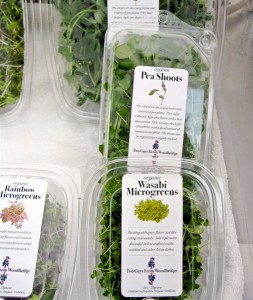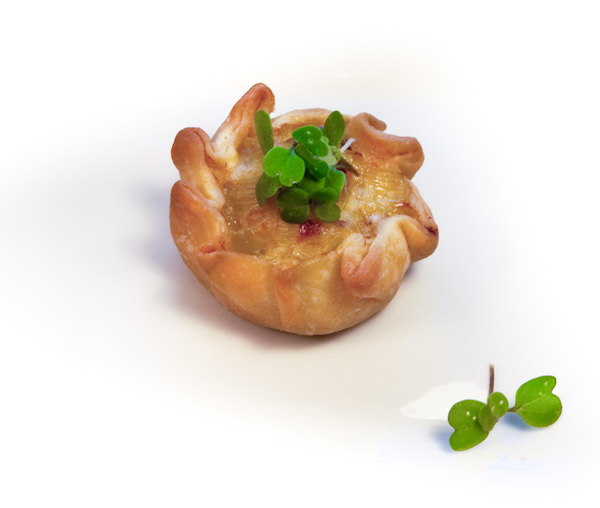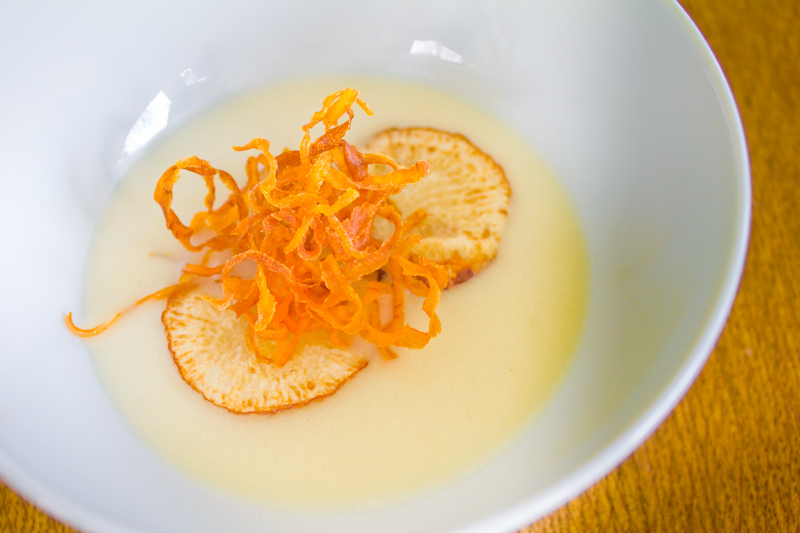Here's a great little dish using those irresistable watermelon radishes and microgreens now growing at a farmers' market near you. Ready in under a half hour, this would be a deceptively easy, super impressive first course for a local-chic dinner soiree. Or triple the scallops, and pair it with cool buckwheat soba noodles dressed with sesame vinaigrette and sprinkled with additional microgreens for a light and springy main course. Either way it uses some of the best items our farmers are offering up at this moment. And after months and months of braised root vegetables, some very welcome fresh leafy crunchy variety.
[caption id="attachment_2004" align="aligncenter" width="600"] 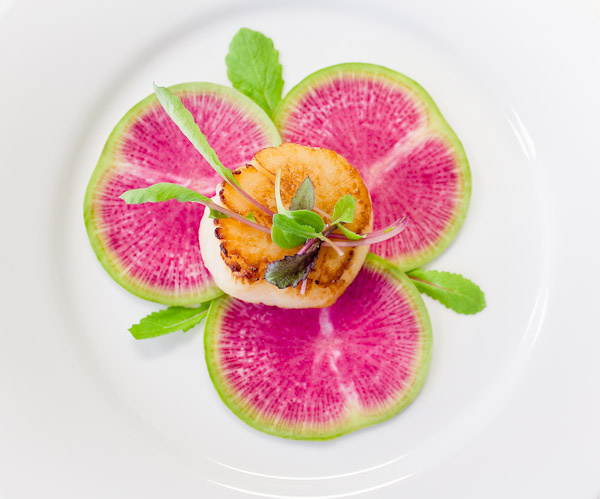 http://www.pitchforkdiaries.com/2011/03/25/pan-seared-sea…crogreen-salad/[/caption] http://www.pitchforkdiaries.com/2011/03/25/pan-seared-sea…crogreen-salad/[/caption] | ||||||||||||||||||||||
 Micro Mesclun from Windfall Farms, Union Square Greenmarket, NYC. Spring is here, and the farmers' market offerings are slowly transitioning from squash, root vegetables, and cold storage foods to fresh spring produce in the weeks ahead. One of the first fresh spring finds to look for are microgreens.
Arugula, lettuces, beets, radish, and kale are very commonly used for microgreens, but cilantro, basil and wasabi are available for a really exciting addition. They are used frequently as a fancy-schmancy garnish in restaurants, offering great color and texture, in addition to a burst of flavor on the top of a dish. But use them at home for a delicate little salad, to top off a piece of grilled seafood, or anywhere you want to add a small bit of freshness without overpowering a recipe with large greens leaves. They are thin and delicate, so are perfectly tender just eaten raw. Keep an eye out for them at the market, or grow your own in some seed flats in your window until the weather gets a little warmer, and then set aside a micro-patch of garden for the rest of the season. Ready in just over a week, I've planned ahead for dinner parties, planting seeds a week or so prior, and snipping fancy-schmancy garnishes of my own hours before my guests arrive. Impressive? Yes. Easy? Yes. Flavorful, healthy, and fun on plate? Yes, yes and more yes. Gruyere and leek tartlette with homegrown arugula microgreens. | ||||||||||||||||
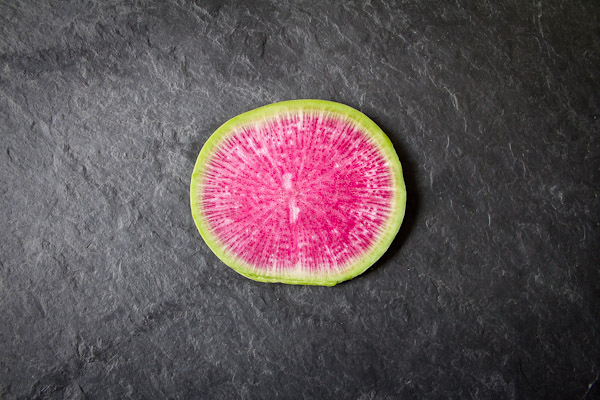 At the Union Square Greenmarket, this past Saturday in Manhattan, I came across giant, stunning Watermelon Radishes. A relative of the Daikon, it is also called Chinese Red Meat, Beauty Heart, and Rose Heart. This is one of the most mild radishes (which, incidentally was the one food I wouldn't touch as a child), with just a slight peppery bite, along with some sweetness and a lot of crunch. But the colors are the real standout here. Off white to lime green on the outside, giving way to brilliant magenta, flecked with tie-dye-reminiscent streaks of white when cut open. Jaw droppingly beautiful on the plate. We have somewhat successfully grown these in our garden the last two summers, but have never had them get quite so big. From some further research I have learned that this variety of radish actually does the best when planted in cooler weather, growing through the winter--which most likely accounts for its sweetness. The ones I found this weekend were nearly four inches in diameter, and about six inches long. But ours at home, grown over the summer in much warmer months, did get to be about twice the size of a golf ball, and still as gorgeous. Due to their unimposing flavor, these can be added to a large variety of dishes, particularly when you want an impressive pop of color. Slice them thin and add to a salad, cut into matchsticks for an extra hue on a crudite plate, lightly pickle to finish off an asian noodle dish, or my favorite, a slice of crusty baguette slathered with really good butter, topped with radish slices and a sprinkling of crunch sea salt. This heirloom radish has gained a lot of popularity in the past few years and is much easier to find as a result. Keep an eye out for the next few weeks at your farmer's markets, or grow some yourself this summer. 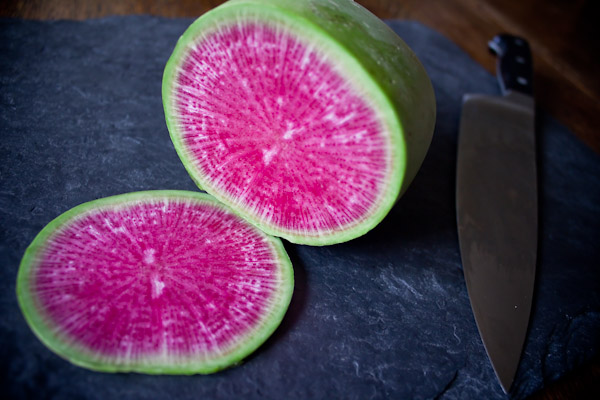 | ||||||||||||||||
Though apples are excellent long-keepers, and will be around for months at the markets, they never taste better to me than right now--sun still warm in the sky, "transition" jacket getting pulled out of the closet, leaves crunching beneath my feet, and halloween fast approaching.
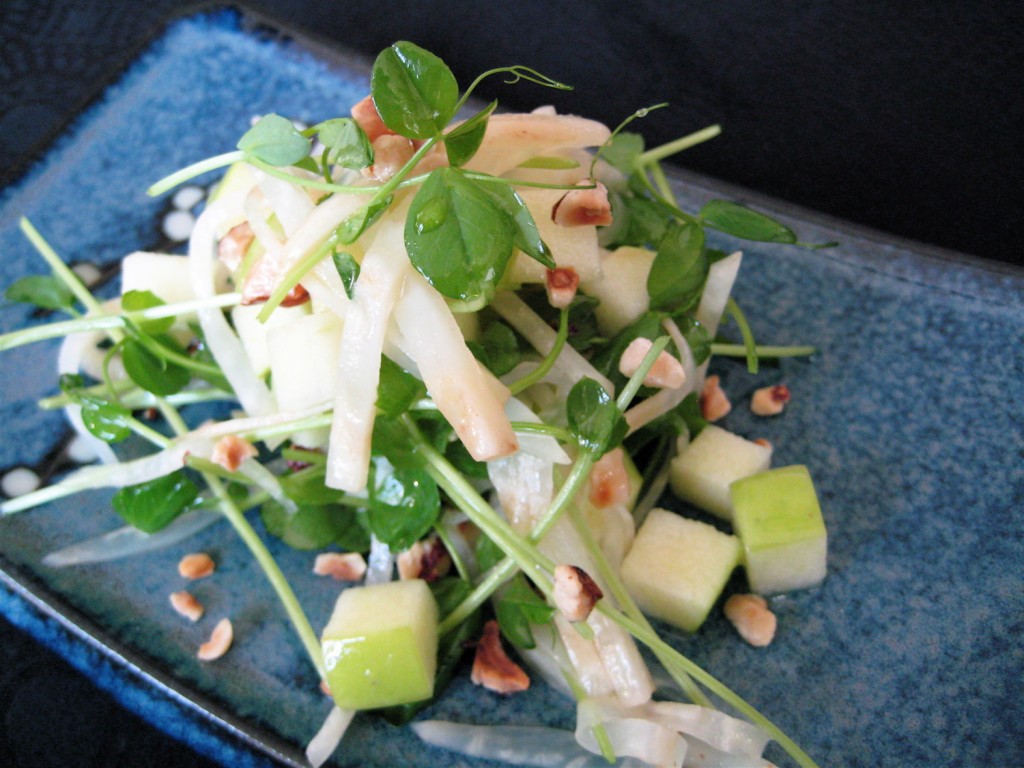 Grab a few extra apples at the farmers' market this week, and try this salad I posted in the early spring. Pea shoots might still be available, but if not, late season salad greens, particularly arugula, would be a great addition. Pea Shoot, Celeriac, Apple and Hazelnut Salad | ||||||||||||||||
|
|
{ welcome! }
 Catie Baumer Schwalb is a chef, food writer and photographer, who splits her life between the city and the country. Not too long ago Catie was a New York City based actress and playwright for more than a decade. She has her Master of Fine Arts from the National Theater Conservatory, and her Grand Diplôme in classic culinary arts from the French Culinary Institute in New York City.
... Read More ≫
Catie Baumer Schwalb is a chef, food writer and photographer, who splits her life between the city and the country. Not too long ago Catie was a New York City based actress and playwright for more than a decade. She has her Master of Fine Arts from the National Theater Conservatory, and her Grand Diplôme in classic culinary arts from the French Culinary Institute in New York City.
... Read More ≫{ get in touch }
{ what's new }
September 12, 2015
August 19, 2013
August 15, 2013
August 13, 2013
August 1, 2013
{ favorites }
{ archives }
Appetizers / Breads & Pastry / Breakfast / Cakes / Canning / Condiments / Dinner / DIY foods / Drinks / Fall / favorites / Grains / Holidays / Local / Noodles & Pasta / Pies & Tarts / Poultry / Salads / Seafood / Snacks / Soup / Spring / Summer / Sweets / Techniques / Vegetables / Vegetarian / Winter /
{ currently reading }
|




